Financial Accounting Report: Analysis of Corporate Liquidations
VerifiedAdded on 2021/06/17
|9
|2702
|29
Report
AI Summary
This report provides a detailed examination of corporate liquidation from a financial accounting perspective. It begins by defining liquidation as the winding-up process of a company unable to meet its liabilities and explores various events leading to this outcome. Real-life examples of Australian corporations, including ABC Learning, HIH Insurance, and One.Tel, are analyzed to illustrate the causes and consequences of liquidation. The report delves into the role of ethics and governance, investigating how poor practices can contribute to financial stress and ultimately lead to business failure. Furthermore, it assesses the impact of liabilities on the liquidation process, highlighting their significance in the downfall of the mentioned companies. The report concludes by summarizing the key factors that contribute to corporate liquidation and the importance of sound financial management and ethical conduct in preventing such outcomes. This report is a contribution to Desklib, a platform offering AI-based study tools.

Financial accounting for the
liquidation
liquidation
Paraphrase This Document
Need a fresh take? Get an instant paraphrase of this document with our AI Paraphraser
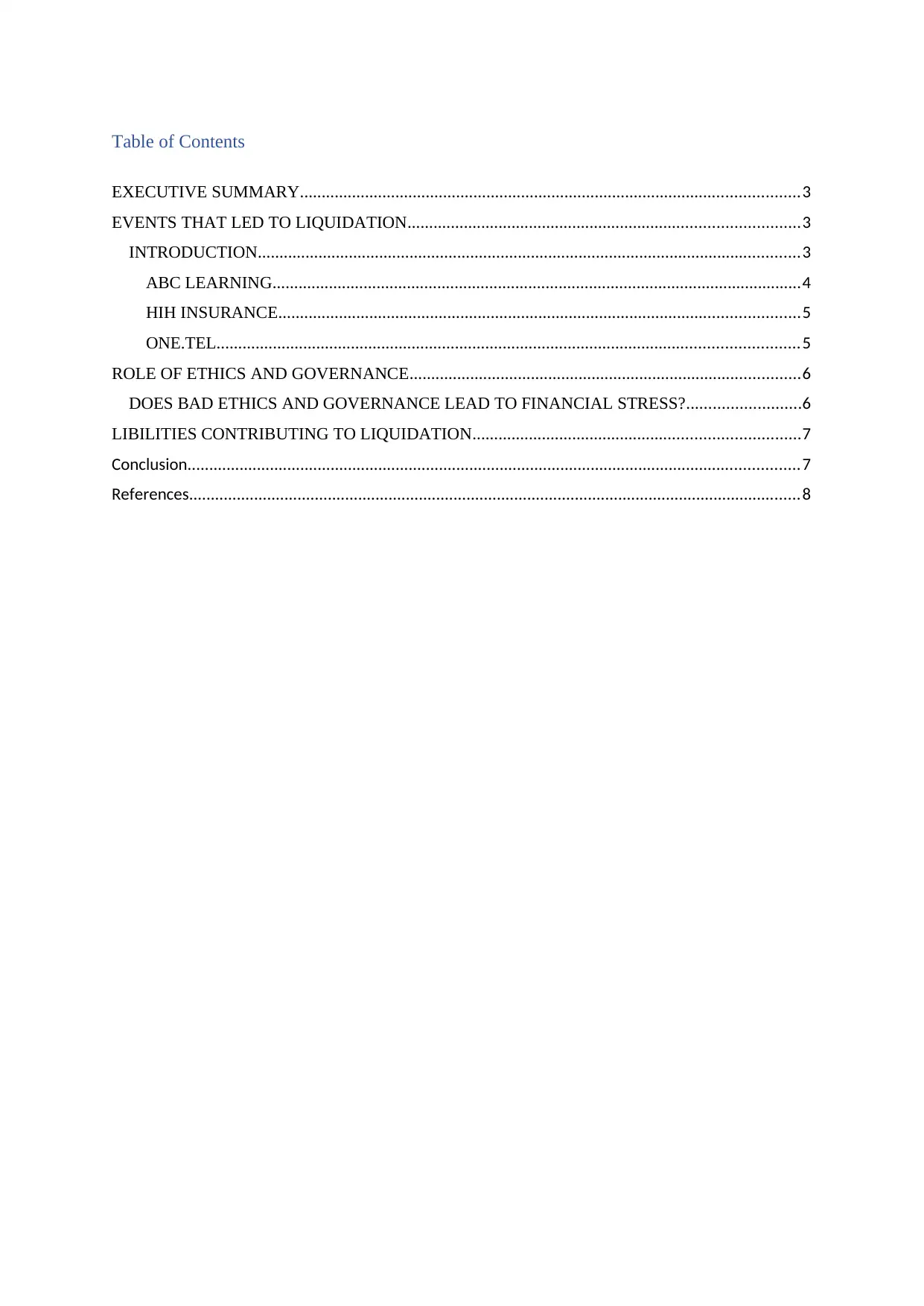
Table of Contents
EXECUTIVE SUMMARY...................................................................................................................3
EVENTS THAT LED TO LIQUIDATION..........................................................................................3
INTRODUCTION.............................................................................................................................3
ABC LEARNING..........................................................................................................................4
HIH INSURANCE........................................................................................................................5
ONE.TEL......................................................................................................................................5
ROLE OF ETHICS AND GOVERNANCE..........................................................................................6
DOES BAD ETHICS AND GOVERNANCE LEAD TO FINANCIAL STRESS?..........................6
LIBILITIES CONTRIBUTING TO LIQUIDATION...........................................................................7
Conclusion.............................................................................................................................................7
References.............................................................................................................................................8
EXECUTIVE SUMMARY...................................................................................................................3
EVENTS THAT LED TO LIQUIDATION..........................................................................................3
INTRODUCTION.............................................................................................................................3
ABC LEARNING..........................................................................................................................4
HIH INSURANCE........................................................................................................................5
ONE.TEL......................................................................................................................................5
ROLE OF ETHICS AND GOVERNANCE..........................................................................................6
DOES BAD ETHICS AND GOVERNANCE LEAD TO FINANCIAL STRESS?..........................6
LIBILITIES CONTRIBUTING TO LIQUIDATION...........................................................................7
Conclusion.............................................................................................................................................7
References.............................................................................................................................................8
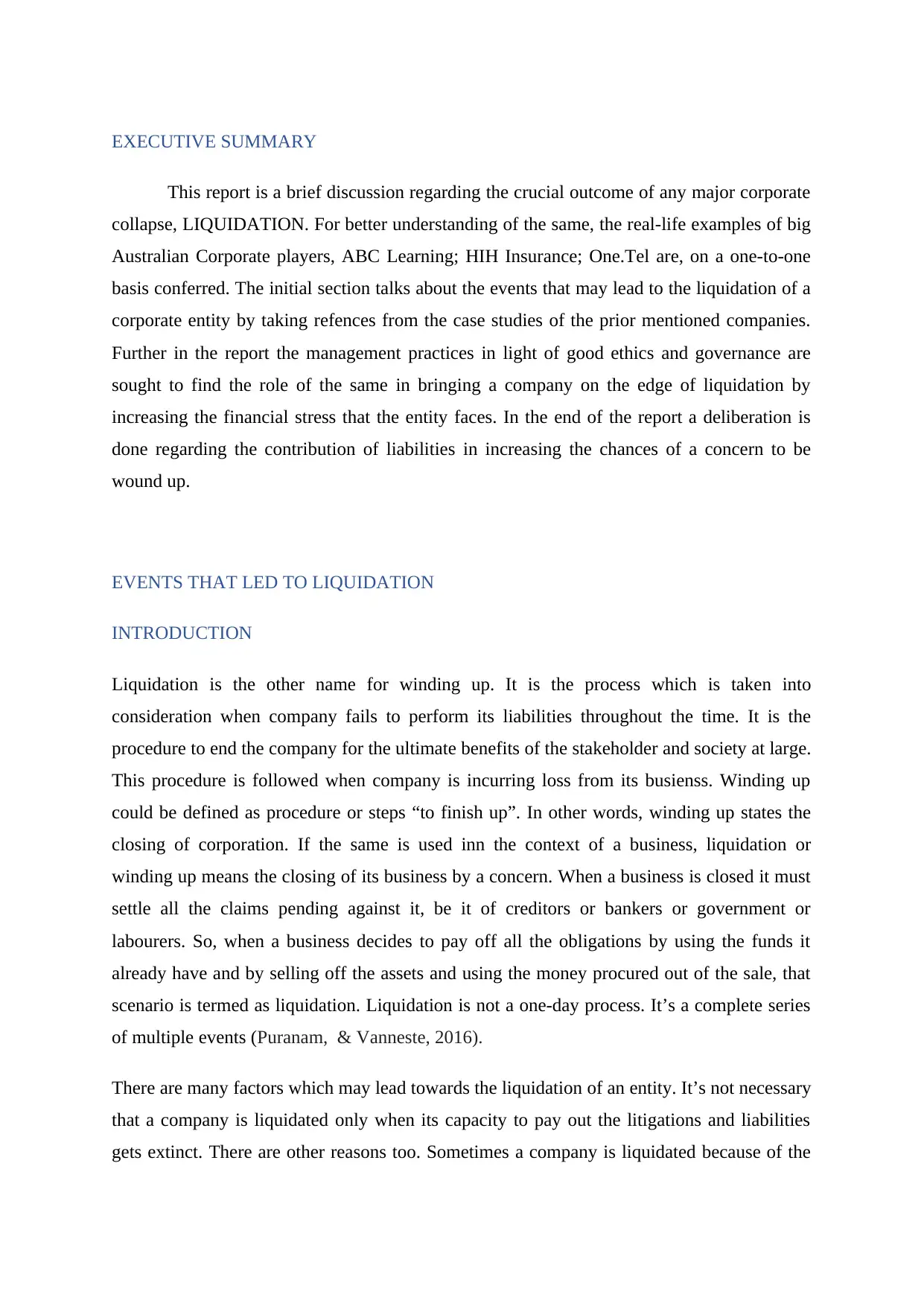
EXECUTIVE SUMMARY
This report is a brief discussion regarding the crucial outcome of any major corporate
collapse, LIQUIDATION. For better understanding of the same, the real-life examples of big
Australian Corporate players, ABC Learning; HIH Insurance; One.Tel are, on a one-to-one
basis conferred. The initial section talks about the events that may lead to the liquidation of a
corporate entity by taking refences from the case studies of the prior mentioned companies.
Further in the report the management practices in light of good ethics and governance are
sought to find the role of the same in bringing a company on the edge of liquidation by
increasing the financial stress that the entity faces. In the end of the report a deliberation is
done regarding the contribution of liabilities in increasing the chances of a concern to be
wound up.
EVENTS THAT LED TO LIQUIDATION
INTRODUCTION
Liquidation is the other name for winding up. It is the process which is taken into
consideration when company fails to perform its liabilities throughout the time. It is the
procedure to end the company for the ultimate benefits of the stakeholder and society at large.
This procedure is followed when company is incurring loss from its busienss. Winding up
could be defined as procedure or steps “to finish up”. In other words, winding up states the
closing of corporation. If the same is used inn the context of a business, liquidation or
winding up means the closing of its business by a concern. When a business is closed it must
settle all the claims pending against it, be it of creditors or bankers or government or
labourers. So, when a business decides to pay off all the obligations by using the funds it
already have and by selling off the assets and using the money procured out of the sale, that
scenario is termed as liquidation. Liquidation is not a one-day process. It’s a complete series
of multiple events (Puranam, & Vanneste, 2016).
There are many factors which may lead towards the liquidation of an entity. It’s not necessary
that a company is liquidated only when its capacity to pay out the litigations and liabilities
gets extinct. There are other reasons too. Sometimes a company is liquidated because of the
This report is a brief discussion regarding the crucial outcome of any major corporate
collapse, LIQUIDATION. For better understanding of the same, the real-life examples of big
Australian Corporate players, ABC Learning; HIH Insurance; One.Tel are, on a one-to-one
basis conferred. The initial section talks about the events that may lead to the liquidation of a
corporate entity by taking refences from the case studies of the prior mentioned companies.
Further in the report the management practices in light of good ethics and governance are
sought to find the role of the same in bringing a company on the edge of liquidation by
increasing the financial stress that the entity faces. In the end of the report a deliberation is
done regarding the contribution of liabilities in increasing the chances of a concern to be
wound up.
EVENTS THAT LED TO LIQUIDATION
INTRODUCTION
Liquidation is the other name for winding up. It is the process which is taken into
consideration when company fails to perform its liabilities throughout the time. It is the
procedure to end the company for the ultimate benefits of the stakeholder and society at large.
This procedure is followed when company is incurring loss from its busienss. Winding up
could be defined as procedure or steps “to finish up”. In other words, winding up states the
closing of corporation. If the same is used inn the context of a business, liquidation or
winding up means the closing of its business by a concern. When a business is closed it must
settle all the claims pending against it, be it of creditors or bankers or government or
labourers. So, when a business decides to pay off all the obligations by using the funds it
already have and by selling off the assets and using the money procured out of the sale, that
scenario is termed as liquidation. Liquidation is not a one-day process. It’s a complete series
of multiple events (Puranam, & Vanneste, 2016).
There are many factors which may lead towards the liquidation of an entity. It’s not necessary
that a company is liquidated only when its capacity to pay out the litigations and liabilities
gets extinct. There are other reasons too. Sometimes a company is liquidated because of the
⊘ This is a preview!⊘
Do you want full access?
Subscribe today to unlock all pages.

Trusted by 1+ million students worldwide
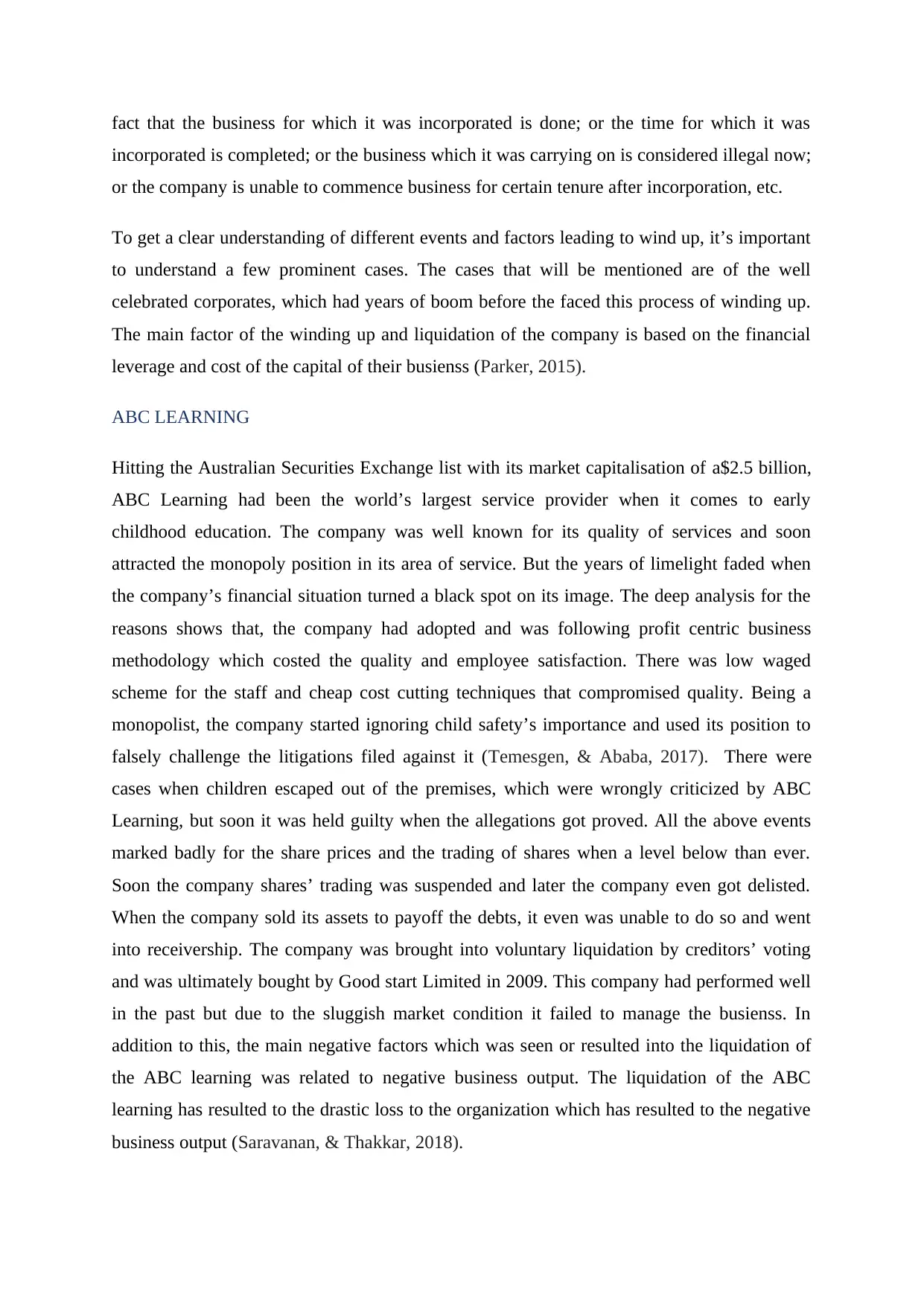
fact that the business for which it was incorporated is done; or the time for which it was
incorporated is completed; or the business which it was carrying on is considered illegal now;
or the company is unable to commence business for certain tenure after incorporation, etc.
To get a clear understanding of different events and factors leading to wind up, it’s important
to understand a few prominent cases. The cases that will be mentioned are of the well
celebrated corporates, which had years of boom before the faced this process of winding up.
The main factor of the winding up and liquidation of the company is based on the financial
leverage and cost of the capital of their busienss (Parker, 2015).
ABC LEARNING
Hitting the Australian Securities Exchange list with its market capitalisation of a$2.5 billion,
ABC Learning had been the world’s largest service provider when it comes to early
childhood education. The company was well known for its quality of services and soon
attracted the monopoly position in its area of service. But the years of limelight faded when
the company’s financial situation turned a black spot on its image. The deep analysis for the
reasons shows that, the company had adopted and was following profit centric business
methodology which costed the quality and employee satisfaction. There was low waged
scheme for the staff and cheap cost cutting techniques that compromised quality. Being a
monopolist, the company started ignoring child safety’s importance and used its position to
falsely challenge the litigations filed against it (Temesgen, & Ababa, 2017). There were
cases when children escaped out of the premises, which were wrongly criticized by ABC
Learning, but soon it was held guilty when the allegations got proved. All the above events
marked badly for the share prices and the trading of shares when a level below than ever.
Soon the company shares’ trading was suspended and later the company even got delisted.
When the company sold its assets to payoff the debts, it even was unable to do so and went
into receivership. The company was brought into voluntary liquidation by creditors’ voting
and was ultimately bought by Good start Limited in 2009. This company had performed well
in the past but due to the sluggish market condition it failed to manage the busienss. In
addition to this, the main negative factors which was seen or resulted into the liquidation of
the ABC learning was related to negative business output. The liquidation of the ABC
learning has resulted to the drastic loss to the organization which has resulted to the negative
business output (Saravanan, & Thakkar, 2018).
incorporated is completed; or the business which it was carrying on is considered illegal now;
or the company is unable to commence business for certain tenure after incorporation, etc.
To get a clear understanding of different events and factors leading to wind up, it’s important
to understand a few prominent cases. The cases that will be mentioned are of the well
celebrated corporates, which had years of boom before the faced this process of winding up.
The main factor of the winding up and liquidation of the company is based on the financial
leverage and cost of the capital of their busienss (Parker, 2015).
ABC LEARNING
Hitting the Australian Securities Exchange list with its market capitalisation of a$2.5 billion,
ABC Learning had been the world’s largest service provider when it comes to early
childhood education. The company was well known for its quality of services and soon
attracted the monopoly position in its area of service. But the years of limelight faded when
the company’s financial situation turned a black spot on its image. The deep analysis for the
reasons shows that, the company had adopted and was following profit centric business
methodology which costed the quality and employee satisfaction. There was low waged
scheme for the staff and cheap cost cutting techniques that compromised quality. Being a
monopolist, the company started ignoring child safety’s importance and used its position to
falsely challenge the litigations filed against it (Temesgen, & Ababa, 2017). There were
cases when children escaped out of the premises, which were wrongly criticized by ABC
Learning, but soon it was held guilty when the allegations got proved. All the above events
marked badly for the share prices and the trading of shares when a level below than ever.
Soon the company shares’ trading was suspended and later the company even got delisted.
When the company sold its assets to payoff the debts, it even was unable to do so and went
into receivership. The company was brought into voluntary liquidation by creditors’ voting
and was ultimately bought by Good start Limited in 2009. This company had performed well
in the past but due to the sluggish market condition it failed to manage the busienss. In
addition to this, the main negative factors which was seen or resulted into the liquidation of
the ABC learning was related to negative business output. The liquidation of the ABC
learning has resulted to the drastic loss to the organization which has resulted to the negative
business output (Saravanan, & Thakkar, 2018).
Paraphrase This Document
Need a fresh take? Get an instant paraphrase of this document with our AI Paraphraser
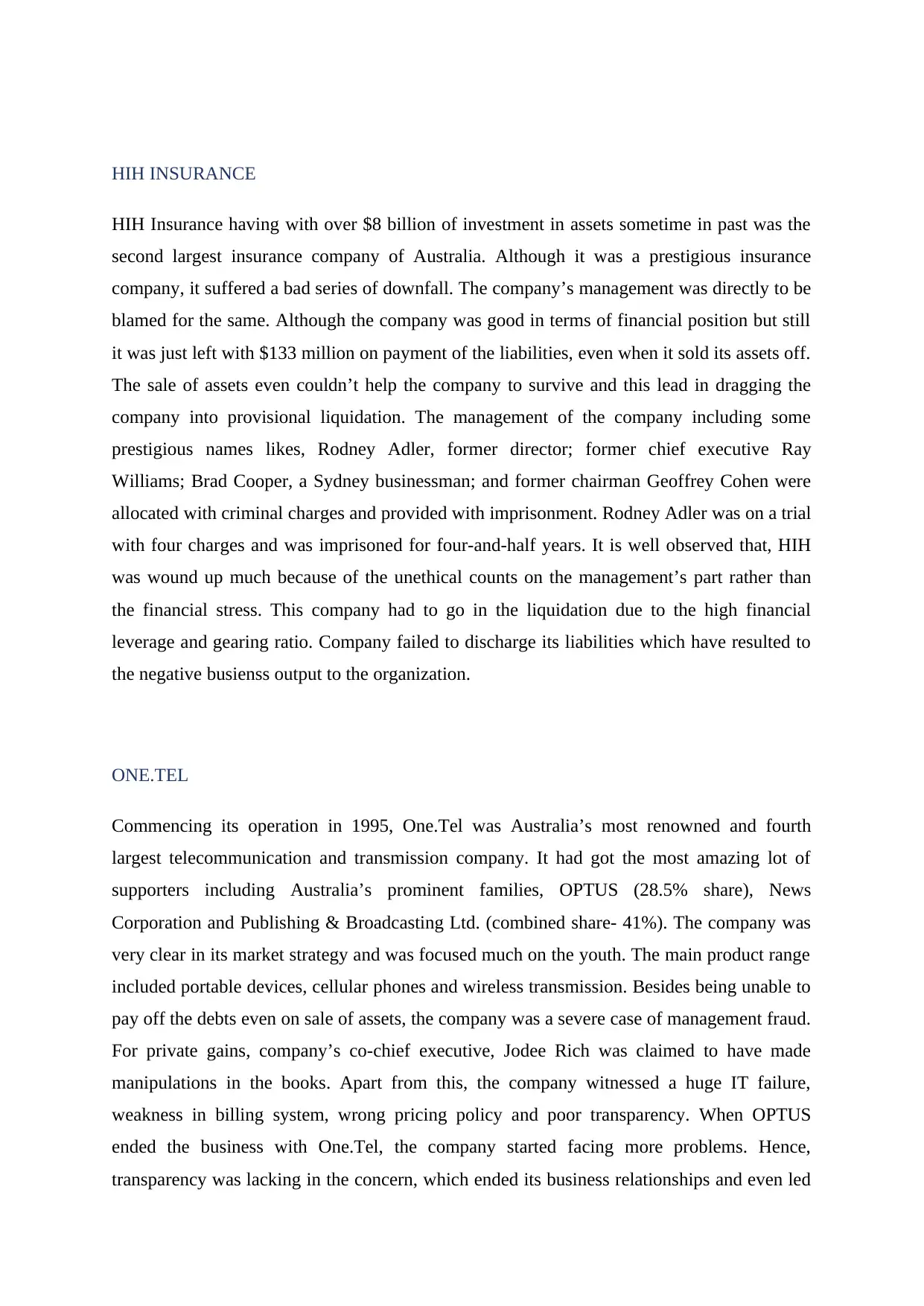
HIH INSURANCE
HIH Insurance having with over $8 billion of investment in assets sometime in past was the
second largest insurance company of Australia. Although it was a prestigious insurance
company, it suffered a bad series of downfall. The company’s management was directly to be
blamed for the same. Although the company was good in terms of financial position but still
it was just left with $133 million on payment of the liabilities, even when it sold its assets off.
The sale of assets even couldn’t help the company to survive and this lead in dragging the
company into provisional liquidation. The management of the company including some
prestigious names likes, Rodney Adler, former director; former chief executive Ray
Williams; Brad Cooper, a Sydney businessman; and former chairman Geoffrey Cohen were
allocated with criminal charges and provided with imprisonment. Rodney Adler was on a trial
with four charges and was imprisoned for four-and-half years. It is well observed that, HIH
was wound up much because of the unethical counts on the management’s part rather than
the financial stress. This company had to go in the liquidation due to the high financial
leverage and gearing ratio. Company failed to discharge its liabilities which have resulted to
the negative busienss output to the organization.
ONE.TEL
Commencing its operation in 1995, One.Tel was Australia’s most renowned and fourth
largest telecommunication and transmission company. It had got the most amazing lot of
supporters including Australia’s prominent families, OPTUS (28.5% share), News
Corporation and Publishing & Broadcasting Ltd. (combined share- 41%). The company was
very clear in its market strategy and was focused much on the youth. The main product range
included portable devices, cellular phones and wireless transmission. Besides being unable to
pay off the debts even on sale of assets, the company was a severe case of management fraud.
For private gains, company’s co-chief executive, Jodee Rich was claimed to have made
manipulations in the books. Apart from this, the company witnessed a huge IT failure,
weakness in billing system, wrong pricing policy and poor transparency. When OPTUS
ended the business with One.Tel, the company started facing more problems. Hence,
transparency was lacking in the concern, which ended its business relationships and even led
HIH Insurance having with over $8 billion of investment in assets sometime in past was the
second largest insurance company of Australia. Although it was a prestigious insurance
company, it suffered a bad series of downfall. The company’s management was directly to be
blamed for the same. Although the company was good in terms of financial position but still
it was just left with $133 million on payment of the liabilities, even when it sold its assets off.
The sale of assets even couldn’t help the company to survive and this lead in dragging the
company into provisional liquidation. The management of the company including some
prestigious names likes, Rodney Adler, former director; former chief executive Ray
Williams; Brad Cooper, a Sydney businessman; and former chairman Geoffrey Cohen were
allocated with criminal charges and provided with imprisonment. Rodney Adler was on a trial
with four charges and was imprisoned for four-and-half years. It is well observed that, HIH
was wound up much because of the unethical counts on the management’s part rather than
the financial stress. This company had to go in the liquidation due to the high financial
leverage and gearing ratio. Company failed to discharge its liabilities which have resulted to
the negative busienss output to the organization.
ONE.TEL
Commencing its operation in 1995, One.Tel was Australia’s most renowned and fourth
largest telecommunication and transmission company. It had got the most amazing lot of
supporters including Australia’s prominent families, OPTUS (28.5% share), News
Corporation and Publishing & Broadcasting Ltd. (combined share- 41%). The company was
very clear in its market strategy and was focused much on the youth. The main product range
included portable devices, cellular phones and wireless transmission. Besides being unable to
pay off the debts even on sale of assets, the company was a severe case of management fraud.
For private gains, company’s co-chief executive, Jodee Rich was claimed to have made
manipulations in the books. Apart from this, the company witnessed a huge IT failure,
weakness in billing system, wrong pricing policy and poor transparency. When OPTUS
ended the business with One.Tel, the company started facing more problems. Hence,
transparency was lacking in the concern, which ended its business relationships and even led
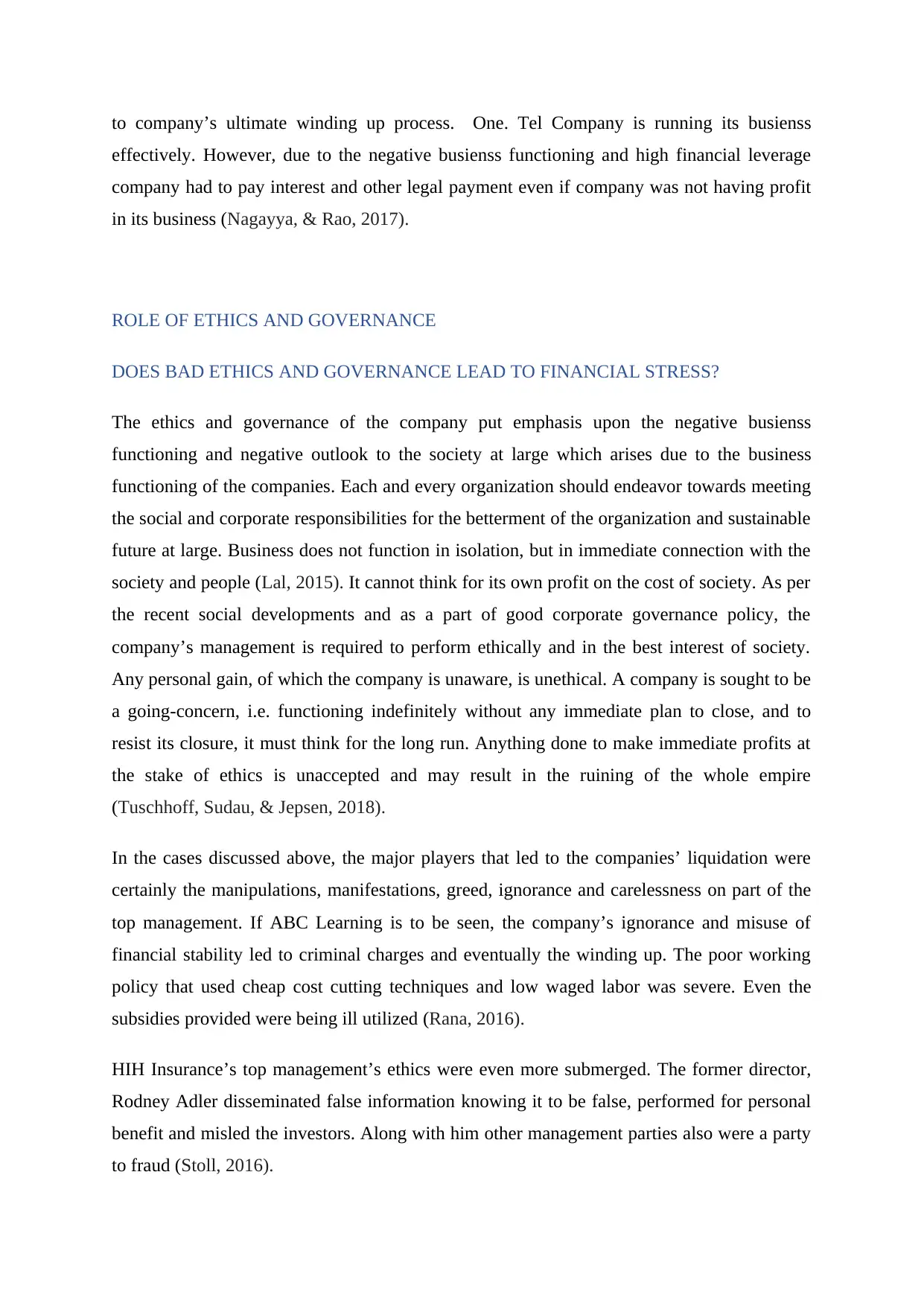
to company’s ultimate winding up process. One. Tel Company is running its busienss
effectively. However, due to the negative busienss functioning and high financial leverage
company had to pay interest and other legal payment even if company was not having profit
in its business (Nagayya, & Rao, 2017).
ROLE OF ETHICS AND GOVERNANCE
DOES BAD ETHICS AND GOVERNANCE LEAD TO FINANCIAL STRESS?
The ethics and governance of the company put emphasis upon the negative busienss
functioning and negative outlook to the society at large which arises due to the business
functioning of the companies. Each and every organization should endeavor towards meeting
the social and corporate responsibilities for the betterment of the organization and sustainable
future at large. Business does not function in isolation, but in immediate connection with the
society and people (Lal, 2015). It cannot think for its own profit on the cost of society. As per
the recent social developments and as a part of good corporate governance policy, the
company’s management is required to perform ethically and in the best interest of society.
Any personal gain, of which the company is unaware, is unethical. A company is sought to be
a going-concern, i.e. functioning indefinitely without any immediate plan to close, and to
resist its closure, it must think for the long run. Anything done to make immediate profits at
the stake of ethics is unaccepted and may result in the ruining of the whole empire
(Tuschhoff, Sudau, & Jepsen, 2018).
In the cases discussed above, the major players that led to the companies’ liquidation were
certainly the manipulations, manifestations, greed, ignorance and carelessness on part of the
top management. If ABC Learning is to be seen, the company’s ignorance and misuse of
financial stability led to criminal charges and eventually the winding up. The poor working
policy that used cheap cost cutting techniques and low waged labor was severe. Even the
subsidies provided were being ill utilized (Rana, 2016).
HIH Insurance’s top management’s ethics were even more submerged. The former director,
Rodney Adler disseminated false information knowing it to be false, performed for personal
benefit and misled the investors. Along with him other management parties also were a party
to fraud (Stoll, 2016).
effectively. However, due to the negative busienss functioning and high financial leverage
company had to pay interest and other legal payment even if company was not having profit
in its business (Nagayya, & Rao, 2017).
ROLE OF ETHICS AND GOVERNANCE
DOES BAD ETHICS AND GOVERNANCE LEAD TO FINANCIAL STRESS?
The ethics and governance of the company put emphasis upon the negative busienss
functioning and negative outlook to the society at large which arises due to the business
functioning of the companies. Each and every organization should endeavor towards meeting
the social and corporate responsibilities for the betterment of the organization and sustainable
future at large. Business does not function in isolation, but in immediate connection with the
society and people (Lal, 2015). It cannot think for its own profit on the cost of society. As per
the recent social developments and as a part of good corporate governance policy, the
company’s management is required to perform ethically and in the best interest of society.
Any personal gain, of which the company is unaware, is unethical. A company is sought to be
a going-concern, i.e. functioning indefinitely without any immediate plan to close, and to
resist its closure, it must think for the long run. Anything done to make immediate profits at
the stake of ethics is unaccepted and may result in the ruining of the whole empire
(Tuschhoff, Sudau, & Jepsen, 2018).
In the cases discussed above, the major players that led to the companies’ liquidation were
certainly the manipulations, manifestations, greed, ignorance and carelessness on part of the
top management. If ABC Learning is to be seen, the company’s ignorance and misuse of
financial stability led to criminal charges and eventually the winding up. The poor working
policy that used cheap cost cutting techniques and low waged labor was severe. Even the
subsidies provided were being ill utilized (Rana, 2016).
HIH Insurance’s top management’s ethics were even more submerged. The former director,
Rodney Adler disseminated false information knowing it to be false, performed for personal
benefit and misled the investors. Along with him other management parties also were a party
to fraud (Stoll, 2016).
⊘ This is a preview!⊘
Do you want full access?
Subscribe today to unlock all pages.

Trusted by 1+ million students worldwide
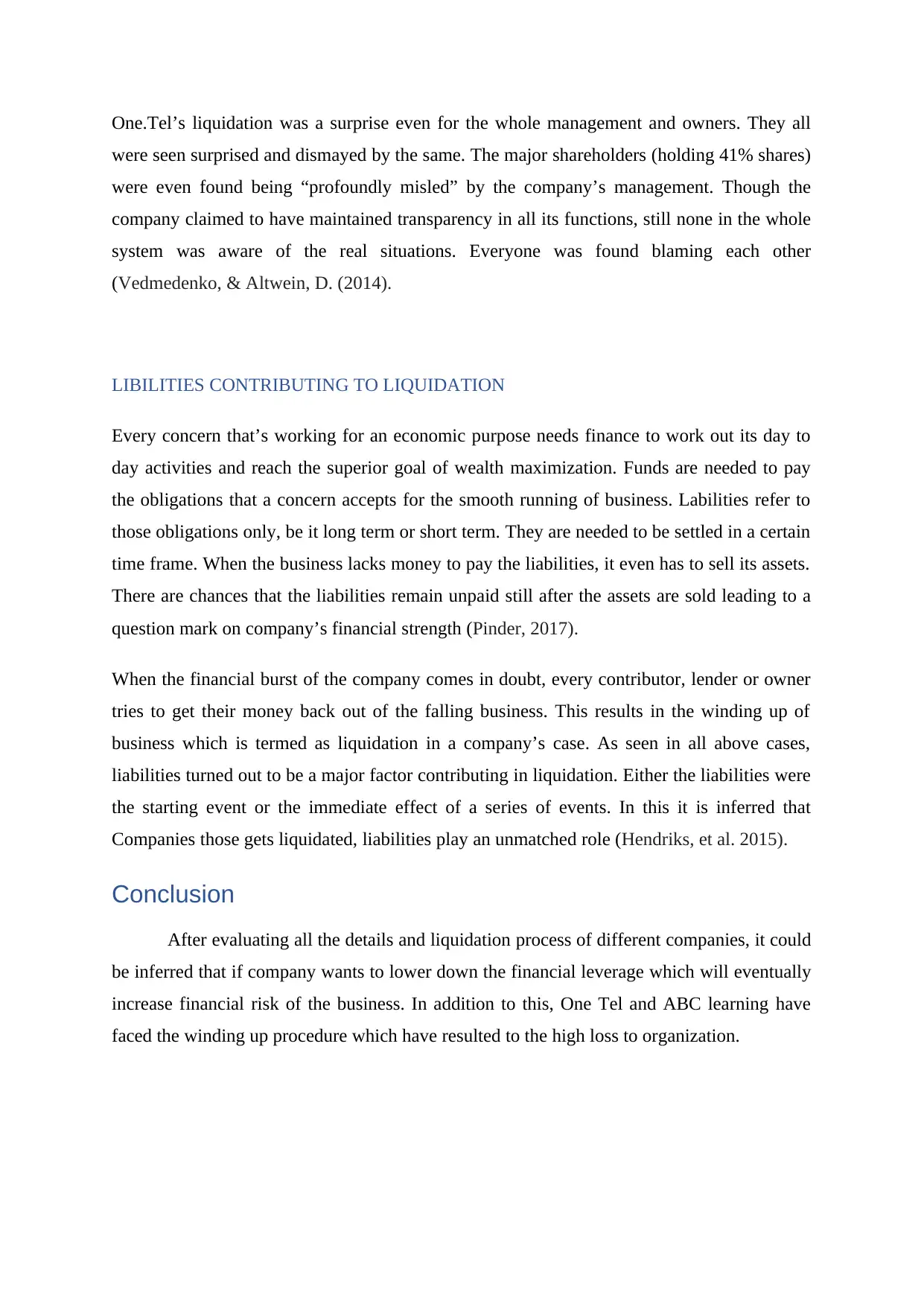
One.Tel’s liquidation was a surprise even for the whole management and owners. They all
were seen surprised and dismayed by the same. The major shareholders (holding 41% shares)
were even found being “profoundly misled” by the company’s management. Though the
company claimed to have maintained transparency in all its functions, still none in the whole
system was aware of the real situations. Everyone was found blaming each other
(Vedmedenko, & Altwein, D. (2014).
LIBILITIES CONTRIBUTING TO LIQUIDATION
Every concern that’s working for an economic purpose needs finance to work out its day to
day activities and reach the superior goal of wealth maximization. Funds are needed to pay
the obligations that a concern accepts for the smooth running of business. Labilities refer to
those obligations only, be it long term or short term. They are needed to be settled in a certain
time frame. When the business lacks money to pay the liabilities, it even has to sell its assets.
There are chances that the liabilities remain unpaid still after the assets are sold leading to a
question mark on company’s financial strength (Pinder, 2017).
When the financial burst of the company comes in doubt, every contributor, lender or owner
tries to get their money back out of the falling business. This results in the winding up of
business which is termed as liquidation in a company’s case. As seen in all above cases,
liabilities turned out to be a major factor contributing in liquidation. Either the liabilities were
the starting event or the immediate effect of a series of events. In this it is inferred that
Companies those gets liquidated, liabilities play an unmatched role (Hendriks, et al. 2015).
Conclusion
After evaluating all the details and liquidation process of different companies, it could
be inferred that if company wants to lower down the financial leverage which will eventually
increase financial risk of the business. In addition to this, One Tel and ABC learning have
faced the winding up procedure which have resulted to the high loss to organization.
were seen surprised and dismayed by the same. The major shareholders (holding 41% shares)
were even found being “profoundly misled” by the company’s management. Though the
company claimed to have maintained transparency in all its functions, still none in the whole
system was aware of the real situations. Everyone was found blaming each other
(Vedmedenko, & Altwein, D. (2014).
LIBILITIES CONTRIBUTING TO LIQUIDATION
Every concern that’s working for an economic purpose needs finance to work out its day to
day activities and reach the superior goal of wealth maximization. Funds are needed to pay
the obligations that a concern accepts for the smooth running of business. Labilities refer to
those obligations only, be it long term or short term. They are needed to be settled in a certain
time frame. When the business lacks money to pay the liabilities, it even has to sell its assets.
There are chances that the liabilities remain unpaid still after the assets are sold leading to a
question mark on company’s financial strength (Pinder, 2017).
When the financial burst of the company comes in doubt, every contributor, lender or owner
tries to get their money back out of the falling business. This results in the winding up of
business which is termed as liquidation in a company’s case. As seen in all above cases,
liabilities turned out to be a major factor contributing in liquidation. Either the liabilities were
the starting event or the immediate effect of a series of events. In this it is inferred that
Companies those gets liquidated, liabilities play an unmatched role (Hendriks, et al. 2015).
Conclusion
After evaluating all the details and liquidation process of different companies, it could
be inferred that if company wants to lower down the financial leverage which will eventually
increase financial risk of the business. In addition to this, One Tel and ABC learning have
faced the winding up procedure which have resulted to the high loss to organization.
Paraphrase This Document
Need a fresh take? Get an instant paraphrase of this document with our AI Paraphraser

References
Alcock, J., Brotchie, J., & Gray, S. (2015). Strategic Liquidation of a Limited Liability Firm.
Hendriks, W., Davids, H., De Vries, R. H. J., & Tuente, B. F. K. (2015). U.S. Patent No.
8,960,258. Washington, DC: U.S. Patent and Trademark Office.
Lal, B. V. (2015). Winding Up the British Empire in the Pacific Islands.
McIntyre, W. D. (2014). Winding Up the British Empire in the Pacific Islands. OUP Oxford.
Nagayya, D., & Rao, B. A. (2017). Entrepreneurship Development: A New Strategy. IUP
Journal of Entrepreneurship Development, 14(1), 7.
Parker, M. (2015). Division 7A and winding up structures. Taxation in Australia, 50(6), 312.
Pinder, J. (2017). Causes and kinds of industrial policy. In National Industrial Strategies and
the World Economy (pp. 41-52). Routledge.
Puranam, P., & Vanneste, B. (2016). Corporate strategy: Tools for analysis and decision-
making. Cambridge University Press.
Rana, S. (2016). Compulsory winding up of companies a study of legislature and judicial
aspects.
Saravanan, J., & Thakkar, J. J. (2018). An integrated approach for lead time reduction of
military aircraft major overhaul: A case of ABC Company. International Journal of
Quality & Reliability Management, 35(1), 2-33.
Stoll, V. M. (2016). The Kanak Awakening: The Rise of Nationalism in New Caledonia by
David A. Chappell, and: Winding Up the British Empire in the Pacific Islands by W.
David McIntyre. Journal of World History, 26(2), 387-394.
Stoll, V. M. (2016). The Kanak Awakening: The Rise of Nationalism in New Caledonia by
David A. Chappell, and: Winding Up the British Empire in the Pacific Islands by W.
David McIntyre. Journal of World History, 26(2), 387-394.
Alcock, J., Brotchie, J., & Gray, S. (2015). Strategic Liquidation of a Limited Liability Firm.
Hendriks, W., Davids, H., De Vries, R. H. J., & Tuente, B. F. K. (2015). U.S. Patent No.
8,960,258. Washington, DC: U.S. Patent and Trademark Office.
Lal, B. V. (2015). Winding Up the British Empire in the Pacific Islands.
McIntyre, W. D. (2014). Winding Up the British Empire in the Pacific Islands. OUP Oxford.
Nagayya, D., & Rao, B. A. (2017). Entrepreneurship Development: A New Strategy. IUP
Journal of Entrepreneurship Development, 14(1), 7.
Parker, M. (2015). Division 7A and winding up structures. Taxation in Australia, 50(6), 312.
Pinder, J. (2017). Causes and kinds of industrial policy. In National Industrial Strategies and
the World Economy (pp. 41-52). Routledge.
Puranam, P., & Vanneste, B. (2016). Corporate strategy: Tools for analysis and decision-
making. Cambridge University Press.
Rana, S. (2016). Compulsory winding up of companies a study of legislature and judicial
aspects.
Saravanan, J., & Thakkar, J. J. (2018). An integrated approach for lead time reduction of
military aircraft major overhaul: A case of ABC Company. International Journal of
Quality & Reliability Management, 35(1), 2-33.
Stoll, V. M. (2016). The Kanak Awakening: The Rise of Nationalism in New Caledonia by
David A. Chappell, and: Winding Up the British Empire in the Pacific Islands by W.
David McIntyre. Journal of World History, 26(2), 387-394.
Stoll, V. M. (2016). The Kanak Awakening: The Rise of Nationalism in New Caledonia by
David A. Chappell, and: Winding Up the British Empire in the Pacific Islands by W.
David McIntyre. Journal of World History, 26(2), 387-394.

Temesgen, H., & Ababa, A. (2017). DISSOLUTION AND WINDING UP OF PLCs
UNDER THE ETHIOPIAN LAW.
Tuschhoff, M., Sudau, P., & Jepsen, O. N. (2018). U.S. Patent No. 9,938,114. Washington,
DC: U.S. Patent and Trademark Office.
Vedmedenko, E. Y., & Altwein, D. (2014). Topologically protected magnetic helix for all-
spin-based applications. Physical review letters, 112(1), 017206.
UNDER THE ETHIOPIAN LAW.
Tuschhoff, M., Sudau, P., & Jepsen, O. N. (2018). U.S. Patent No. 9,938,114. Washington,
DC: U.S. Patent and Trademark Office.
Vedmedenko, E. Y., & Altwein, D. (2014). Topologically protected magnetic helix for all-
spin-based applications. Physical review letters, 112(1), 017206.
⊘ This is a preview!⊘
Do you want full access?
Subscribe today to unlock all pages.

Trusted by 1+ million students worldwide
1 out of 9
Related Documents
Your All-in-One AI-Powered Toolkit for Academic Success.
+13062052269
info@desklib.com
Available 24*7 on WhatsApp / Email
![[object Object]](/_next/static/media/star-bottom.7253800d.svg)
Unlock your academic potential
Copyright © 2020–2025 A2Z Services. All Rights Reserved. Developed and managed by ZUCOL.





